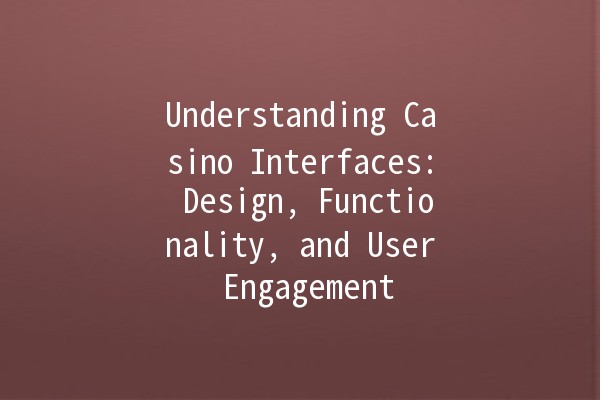In the world of online gaming, the design and functionality of a casino interface play a critical role in attracting and retaining players. The interface serves as a bridge between the user and the gaming experience, influencing everything from navigation ease to customer satisfaction. With the competitive nature of the online casino industry, understanding and optimizing the casino interface can lead to significant advantages. Here, we delve into effective techniques for enhancing casino interfaces, along with insights into their practical applications.
What Makes a Great Casino Interface?
A great casino interface is characterized by intuitive design, responsive functionality, and an engaging user experience. It should seamlessly connect players with games while providing all the necessary tools to enhance gameplay. Below are five productivityenhancing techniques for optimizing casino interfaces, each explorable in detail for maximum impact.
Explanation:
Intuitive navigation is paramount in ensuring players can easily find their favorite games and access important information without frustration. Clear categorization of games, along with search tools, creates a streamlined experience.

Application Example:
An online casino can implement a tabbed menu that categorizes games into sections such as slots, table games, and live dealer options. Additionally, a prominent search bar can assist users in finding specific games quickly. This design could increase the average session duration by reducing the time players spend looking for games.
Explanation:
With an increasing number of players accessing casinos via mobile devices, a responsive design that adapts to various screen sizes is essential. This flexibility ensures a smooth and enjoyable experience irrespective of the device.
Application Example:
Creating a responsive casino interface means designing all game elements and navigation tools to resize dynamically. For instance, buttons that are wellspaced on desktop should remain accessible on mobile devices, and graphical content should scale without losing clarity. Testing across devices before launching is vital to ensure functionality remains consistent.
Explanation:
The visual appeal of a casino interface is crucial for user engagement. Colors, fonts, images, and animations should align with the casino's branding while being visually stimulating to attract players.
Application Example:
Consider a casino that uses a visually striking theme related to its brand—such as a Vegasinspired atmosphere. Engaging animations when users hover over games can add a layer of excitement. Utilizing highquality images for games and promotional banners helps create a vibrant experience that draws players back.
Explanation:
Incorporating usercentric features enhances the experience by meeting players' needs. This includes personalizing game suggestions based on players’ past behavior or allowing customization of their interface.
Application Example:
An effective usercentric feature could be a recommended games section on the homepage that updates based on a player's gaming history. This presents tailored options that encourage reengagement. Additionally, providing options for players to modify the interface—like changing game views or adjusting sound settings—can foster a sense of ownership and satisfaction.
Explanation:
A secure, straightforward payment process plays a pivotal role in the overall user experience. Gamers should be able to deposit and withdraw funds effortlessly without facing technical complications.
Application Example:
Integrating multiple payment options, from credit cards to ewallets and cryptocurrencies, ensures players can choose their preferred method. Utilizing a simple checkout process with clear prompts and confirmations reduces friction—leading to higher conversion rates during deposits. Moreover, providing a FAQ or support chat during transactions can reassure users and minimize anxiety.
Why is Interface Design Essential for User Retention?
The interface of an online casino significantly influences user retention rates. A welldesigned casino environment can encourage repeat visits and foster customer loyalty. If a user feels at ease navigating the platform, they are likely to spend more time gaming and interacting with other players.
Engagement Through Gamification
Integrating elements of gamification into the interface can further enhance user engagement. Features such as leaderboards, achievement badges, and regular tournaments create a sense of community and competition. This, combined with healthily designed interfaces, keeps players coming back for more.
Feedback Mechanisms
An effective interface is one that allows for feedback. A small survey popup after gaming sessions can provide invaluable insights into user experiences. Adjustments made based on this feedback can optimize the interface continuously, creating a more engaging environment for returning users.
The casino interface is undeniably a vital component that shapes players’ online experiences. Through intuitive navigation, responsive design, engaging visuals, usercentric features, and seamless payment processes, online casinos can build interfaces that not only attract but also retain players. By focusing on these key elements, casinos can bolster their appeal and ensure a thriving online presence.
Frequently Asked Questions
A successful casino interface should prioritize intuitive navigation, responsive design, engaging visuals, usercentric features, and seamless payment integration. Each of these elements contributes to a frictionless user experience and enhances overall satisfaction.
Mobile compatibility is crucial as a significant number of players access online casinos via smartphones and tablets. A responsive design that adjusts to various screen sizes ensures that users have a positive experience, regardless of the device they choose.
Visual design plays a significant role in attracting and retaining players. A wellthoughtout aesthetic that aligns with the brand can enhance the overall experience, making it more engaging and enjoyable for users.
Casinos can personalize user experiences by implementing features that suggest games based on past gameplay, allow customization of the interface, and create personalized promotions to enhance player engagement.
Integrating multiple payment methods allows users to choose their preferred payment options, making deposits and withdrawals easier. This convenience can lead to lower abandonment rates during transactions and increase player retention.
Gathering user feedback enables casinos to identify pain points and areas for improvement within the interface. Continuous optimization based on player suggestions helps enhance user satisfaction and encourages frequent visits.
By applying and embracing these strategies, casinos can significantly uplift their interfaces, making them more userfriendly and engaging, ultimately contributing to better business outcomes.